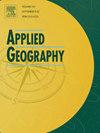加强城乡互联互通,优化特大城市生态安全格局——来自中国武汉的启示
IF 4
2区 地球科学
Q1 GEOGRAPHY
引用次数: 0
摘要
传统的城市生态网络研究方法往往不能解决密集城市化地区与其邻近农村地区之间的生态隔离问题。为了克服这一挑战,本研究引入了一种新的方法来建立城乡生态网络,重点是城乡梯度的景观异质性(URGs)。该方法基于“形态-质量-尺度”框架区分城乡生态源,并利用最小累积阻力模型模拟城乡生态廊道。利用图论和电路理论对城乡多物种网络进行了生物多样性和生态保护优化。结果表明:(1)优化后的城乡生态网络包括114家中小企业和288家中小企业,主要集中在南部和北部农村地区,城郊和城区分布较为分散;与传统策略相比,该网络的α、β和γ指数分别为0.78、2.53和0.85,从而成功地增强了城乡之间的生态连通性。(2)多物种网络的优化改善了网络的结构和连通性,特别是对于中长迁移距离(≥10 km)的物种。(3)基于“两核、六带、六带”生态安全格局,提出了由重点保护区、重点修复区、生态提升区组成的生态分区保护与修复战略。研究结果表明,该策略可以有效地加强城乡生态联系,为特大城市生态保护政策提供有价值的参考。本文章由计算机程序翻译,如有差异,请以英文原文为准。
Optimizing ecological security patterns in a megacity by enhancing urban-rural connectivity: Insights from Wuhan, China
Traditional approaches to urban ecological networks (ENs) often fail to address the ecological isolation between densely urbanized areas and their adjacent rural regions. To overcome this challenge, this study introduced a novel methodology for establishing urban-rural ENs, with an emphasis on landscape heterogeneity across urban-rural gradients (URGs). The approach distinguished urban and rural ecological sources (ESs) based on the “morphology-quality-scale” framework and simulated distinct urban-rural ecological corridors (ECs) using the minimum cumulative resistance model, incorporating both general and urban-rural specific resistance factors. Additionally, multi-species urban-rural ENs for biodiversity and ecological protection were optimized using graph theory and circuit theory. The results showed that: (1) The optimized urban-rural ecological network encompassed 114 ESs and 288 ECs, which were predominantly clustered in the southern and northern rural regions, whith a more dispersed pattern in suburban and urban areas. Compared to traditional strategies, the proposed network achieved α, β, and γ indices of 0.78, 2.53, and 0.85, respectively, thereby successfully enhancing ecological connectivity between urban and rural areas. (2) The optimization of the multi-species ENs improved their structure and connectivity across URGs, particularly for species with medium or long migration distances (≥10 km). (3) An ecological zoning protection and restoration strategy, comprising key protected areas, priority restoration areas, and ecological upgrading areas, was proposed based on an ecological security pattern of “two cores, six zones, and six straps.” These findings suggest that the proposed strategy can effectively strengthen urban-rural ecological linkages and provide valuable insights for ecological conservation policies in megacities.
求助全文
通过发布文献求助,成功后即可免费获取论文全文。
去求助
来源期刊

Applied Geography
GEOGRAPHY-
CiteScore
8.00
自引率
2.00%
发文量
134
期刊介绍:
Applied Geography is a journal devoted to the publication of research which utilizes geographic approaches (human, physical, nature-society and GIScience) to resolve human problems that have a spatial dimension. These problems may be related to the assessment, management and allocation of the world physical and/or human resources. The underlying rationale of the journal is that only through a clear understanding of the relevant societal, physical, and coupled natural-humans systems can we resolve such problems. Papers are invited on any theme involving the application of geographical theory and methodology in the resolution of human problems.
 求助内容:
求助内容: 应助结果提醒方式:
应助结果提醒方式:


